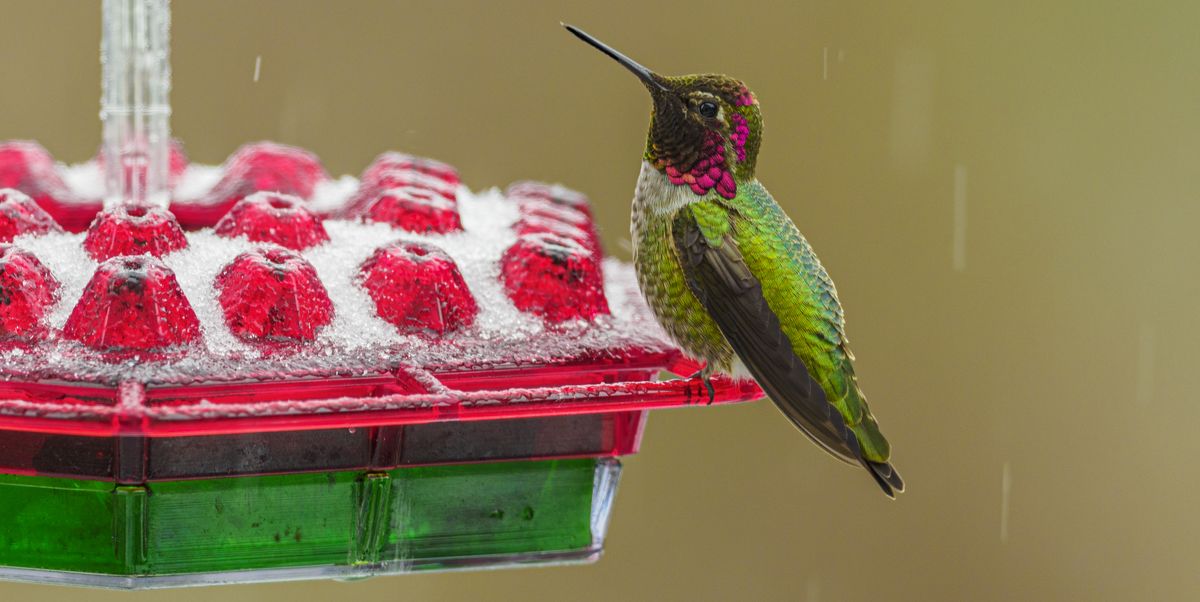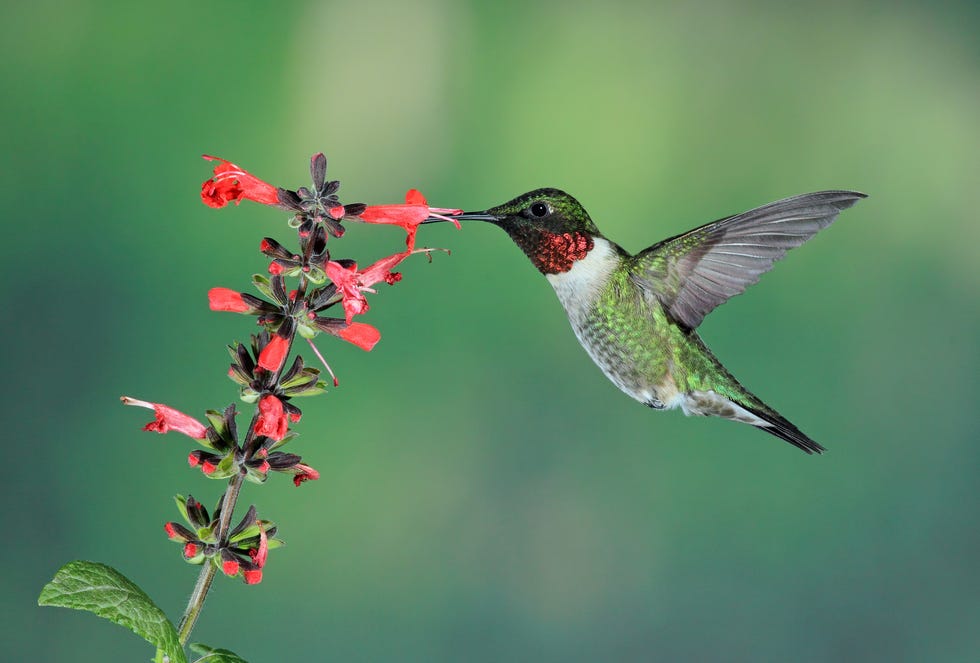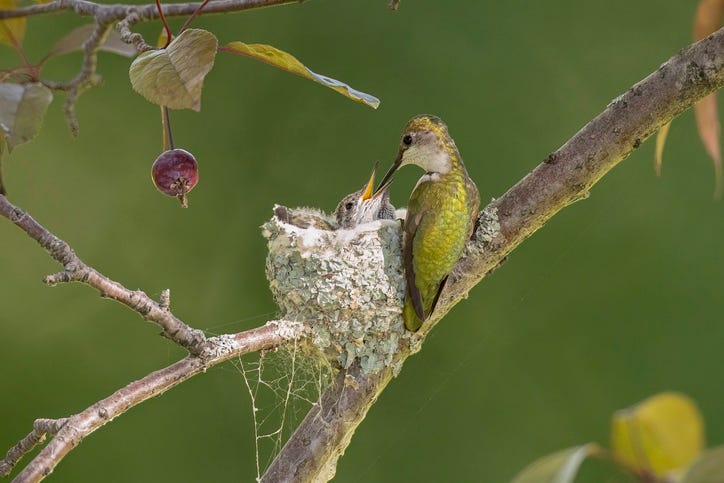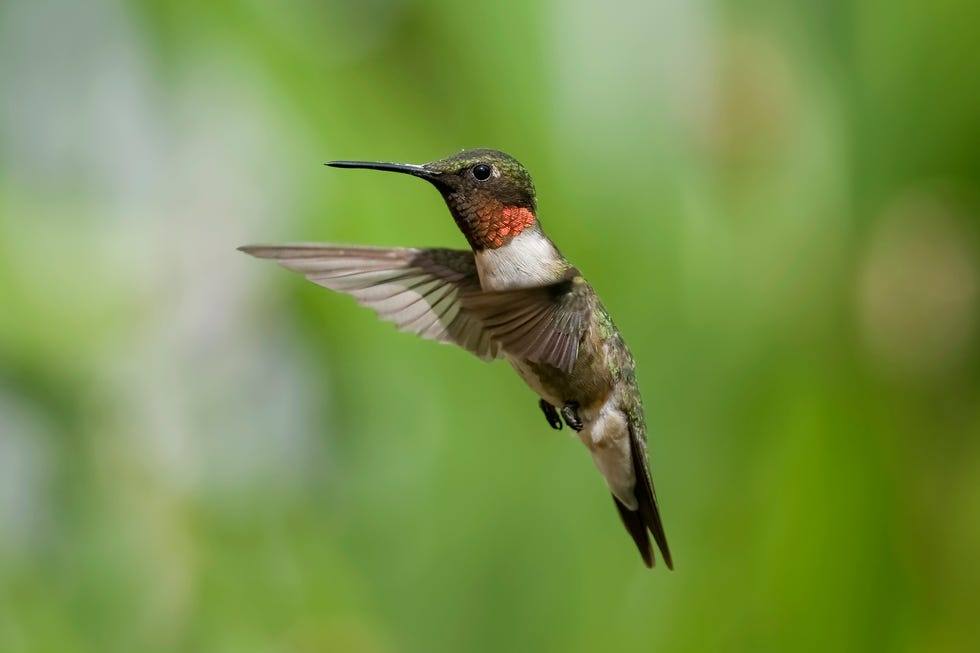Hummingbirds are pretty amazing creatures. They’re the smallest bird—most weigh less than a nickel—and they’re also the only bird that can fly backward. In terms of speed, they can set some records: their hearts beat upwards of 1,200 times per minute when they’re flying, and their wings can beat upwards of 80 times per second!
Being so small and so delicate looking, you might wonder what happens to those little guys when it starts to get really cold out. But they’re much tougher than they look. Especially the ones here: Of the more than 360 known species, only about 15 are found in North America, and while most hummingbirds don’t migrate, almost all of the ones that live here do, and some travel very, very far.
The most widely-known hummingbird, the ruby-throated hummingbird, travels from as far north as lower Canada, all the way to Central America. Other birds such as the rufous hummingbird travel from as far north as Alaska all the way to the Southwestern US and Mexico. That’s one of the longest migrations in the world—especially as measured by body size!
That migration may be faster than you think: “A long-distance migration from North America to Central America probably takes 2 to 3 weeks depending on how long they stay at resting spots along the way,” said Emma Grieg, PhD, the late project leader of Project FeederWatch at the Cornell Lab of Ornithology.
When Country Living interviewed Dr. Grieg last year, she addressed a few more of our most common questions about hummingbird travel.
Mike Bons//Getty Images
Why Do Hummingbirds Migrate?
In short, to find food: “The shortening days in northern latitudes cue them to make a move before all the food disappears,” said Grieg.
Before they head south, they stock up on as much nourishment as they can before migrating. That’s why it’s helpful to keep your hummingbird feeder up until a few weeks after you see the last hummers in your garden.
Related StoriesWhen Do Hummingbirds Migrate?
You’ll start to see them move south from northern latitudes sometime in late summer to early fall, said Grieg.
But don’t worry: hummers won’t get confused if you keep your feeder up throughout the fall. Keeping food available doesn’t interfere with migration.
It actually gives them a nice boost of energy as they begin or continue their trips south. “Your feeders will not keep them from migrating,” said Grieg.
In fact, if you live somewhere that sees hummers all winter, such as south Texas or Florida, it’s fine to leave your feeders up all year to enjoy their antics.
Stan Tekiela Author / Naturalist / Wildlife Photographer//Getty Images
Do Hummingbirds Migrate Together?
Actually, hummingbirds travel solo, as they live much of their lives. “Hummingbirds aren’t particularly social birds,” said Grieg. “The males tend to leave first. Because they don’t help with rearing young, they can hit the road before females do.”
And no matter what social media myths you’ve read, they do not hitch a ride on the backs of geese! They’re on their own for the long journey south.
Daniel Ripplinger / DansPhotoArt//Getty Images
Do Hummingbirds Come Back to the Same Place Every Year?
“Some do, yes!” said Grieg. “From research on banded birds, we have found that some hummingbirds come back to the same yards year after year.”
So, keep your feeders full and plant plenty of hummingbird-attracting flowers so you can be ready for them to return to your garden next spring!
What Is the Life Expectancy of a Hummingbird?
While most hummingbirds in North America live only a few years—typically between 3 and 5 years—there are individual birds that have been known to live much longer. The Cornell Ornithology Lab has documented a Ruby-throated Hummingbird that was over 9 years old and a Rivoli’s Hummingbird that was at least 11!
While hummingbirds are fast, there are animals that will prey on them, including other birds like smaller hawks and kestrels, as well as occasional poisonous spiders, preying mantises, and of course cats. So if you have a cat be sure to keep it well away from your feeder at all times.
Where Do Hummingbirds Go at Night?
Hummingbirds, believe it or not, are deep sleepers! After a long day of activity, sometimes gathering nectar from hundreds and hundreds of flowers, they return to their nest or to a safely hidden branch and enter a kind of sleep known as torpor.
In torpor, their body temperature, heart rate, and metabolism all drop drastically, much like a mini-hibernation. It can take them up to 30 minutes to return to their daytime state. They’re among only a few species of birds known to do this.
Related Story
Emma Greig, Ph.D., was the longtime Project Leader of Project FeederWatch, a program at the Cornell Lab of Ornithology that crowdsources data from the public to study and understand the distribution and abundance of birds that visit feeders in North America. Prior to joining the FeederWatch team in 2013, Emma was a postdoctoral associate in Macaulay Library at the Cornell Lab of Ornithology. Emma held a Ph.D. from the University of Chicago and studied birds in Australia, Malaysia, and Hawaii. In December 2024, Emma passed away from cancer at age 43.




